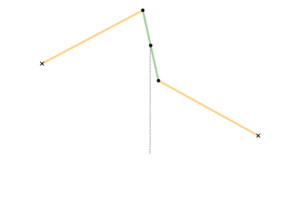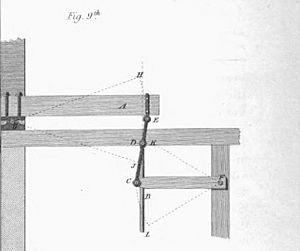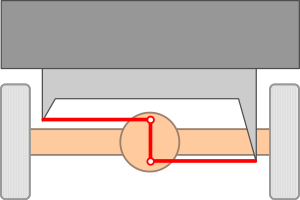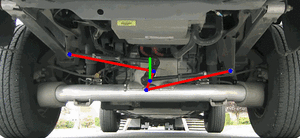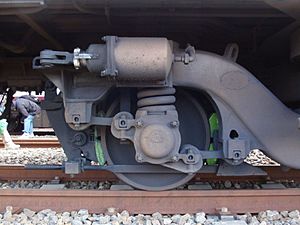Watt's linkage facts for kids
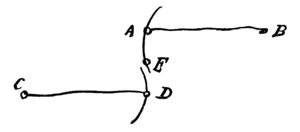
Watt's linkage is a special mechanical system invented by James Watt. It helps a moving part travel in a nearly straight line. Watt created this linkage in 1784 for his famous Watt steam engine.
Today, you can find Watt's linkage in some car suspensions. It helps car wheels move up and down smoothly without wobbling from side to side.
Contents
What Is It?
Watt's linkage is made of three metal bars connected together. There are two longer bars on the outside, and a shorter bar in the middle. The middle bar connects to the ends of the two outer bars. All these connections are like hinges, letting the bars pivot or swing.
The outer ends of the two long bars are fixed in place. Even though they are fixed, the three bars can still swing around their connection points. Think of it like a chain of bars that can bend.
This system is a type of "four-bar linkage." The "fourth bar" is an imaginary line connecting the two fixed points where the long bars are attached.
How It Was Invented
James Watt first thought of this idea in June 1784. He wrote a letter to his business partner, Matthew Boulton, saying:
I have got a glimpse of a method of causing a piston rod to move up and down perpendicularly by only fixing it to a piece of iron upon the beam, without chains or perpendicular guides [...] and one of the most ingenious simple pieces of mechanics I have invented.
Watt was very proud of this invention! It was a clever way to make parts move straight without needing complicated guides or chains.
This linkage was part of Watt's patent from April 1784. However, the design he described in his letter was a slightly newer version. This improved design, called a parallel motion linkage, was even better. It saved space and was used in his steam engines.
During the Industrial Revolution, engineers needed ways to change spinning motion into straight-line motion. Watt's linkage was a simple and effective solution. It helped machines work better and for longer periods.
The Path It Makes
Watt's linkage doesn't make a perfectly straight line. Instead, the middle point traces a path that looks a bit like a figure eight. Watt knew this. He said that the path has "very little sensible variation from a straight line." This means it's so close to a straight line that it works perfectly for many machines.
There are other, more complex systems that make a true straight line. But Watt's linkage is much simpler to build. This simplicity made it very useful for its time.
How It's Used Today
In Steam Engines
Early steam engines used chains to connect the piston to the engine's main beam. This worked fine for pumping water. But for engines that needed to create spinning motion, a stronger connection was needed. Watt's linkage allowed the piston to push and pull the beam. This meant the engine could use steam on both sides of the piston, making it more powerful.
The nearly straight motion of the linkage kept the piston from getting stuck inside its cylinder. This also made the engine run more smoothly. The specific linkage Watt used in his later engines was a bit different, called the parallel motion linkage, but it used the same basic idea.
In Car Suspensions
Watt's linkage is used in the rear suspension of some cars. It's an improvement over an older design called the Panhard rod. Both systems stop the car's axle from moving sideways. Watt's linkage does a better job of keeping the axle centered and moving straight up and down.
Here's how it works in a car:
- Two horizontal bars of the same length are attached to the car's frame.
- A short vertical bar connects these two horizontal bars.
- The very center of this short vertical bar is attached to the middle of the car's axle.
All the connection points can swing freely in a vertical direction.
Think of it like two Panhard rods working against each other. The small curves made by each rod cancel each other out in the short vertical bar. This results in a much straighter up-and-down motion for the axle.
Sometimes, this linkage is used upside down. In this case, the center point is attached to the car body, and the outer bars connect to the axle. This can make the car lighter and change how it handles slightly.
Watt's linkage can also be used to stop the axle from moving forwards and backwards in the car. This would involve two Watt's linkages on each side of the axle.
See also
- Four-bar linkage
- Linkage (mechanical)
- Straight line mechanism
- Watt's Parallel motion linkage, a straight line linkage built off of Watt's linkage.


